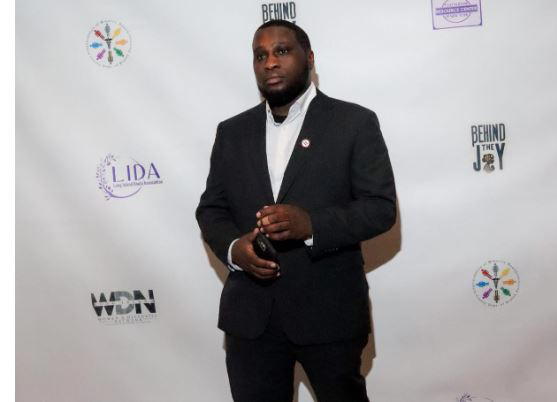By Ayo Onikoyi
Independent filmmaker and director, Mr. Jamal Smart, based in New York City has opened up on his latest unreleased film, “Behind the Joy”.
According to him, the film is an emotional and thought-provoking exploration of postpartum depression through the lens of a young, married couple.
In this interview with Ayo Onikoyi, Entertainment Editor, VANGUARD, Jamal shares how the film explores the rawness of the experience, while spotlighting the confusion, isolation and unexpected emotional distance many couples endure. He says at the core of “Behind the Joy” is a story of love, resilience, and the human need for understanding amid quiet suffering
With his background in theatre and community-driven storytelling, Jamal has dedicated his career to spotlighting underrepresented voices and lived experiences that often go untold on screen and “Behind the Joy” underscores this in a most poignant manner. Hear him. EXCERPTS:
What initially drew you to postpartum depression as a central theme for your film “Behind the Joy”?
When I had my child at 16, people started treating me like I was an expert, lol. As my community began having children, they’d confide in me about their feelings, some good, some troubling, and some that made you pause. A lot of them couldn’t even explain what was going on in their heads, but I always made space to listen and validate them. Almost three years ago, my sister had her first child, and by then I had a better understanding of what postpartum depression looks like. Because it hit so close to home, I wanted to create a story, almost like a visual guide, to show what Perinatal Mood and Anxiety Disorders can look like from a real, lived-in perspective.
As someone with a background in theatre and community storytelling, how did those experiences shape your approach to this film’s narrative and characters?
I wanted the story to feel as real as possible. Before writing the script, I did a case study with about 30 women who went through Perinatal Mood and Anxiety Disorders. Many shared stories about who showed up for them or who didn’t. I saw a lot of myself in their experiences. For example, one common theme was how people would call a new mom and immediately ask, “How’s the baby?” The women felt like they didn’t matter, like they were just a third wheel in their own lives. I reverse engineered that feeling and built Naomi’s world around it, so viewers could see how even well-meaning words can unintentionally cause emotional harm.
You mentioned that real conversations with mothers in your life inspired this project. Was there a particular moment or story that catalyzed the script?
Yes, my friend Niecey, who’s also part of the “16 and pregnant” gang, lol, told me once that her daughter wouldn’t stop crying one night. She tried everything, but eventually she hit a breaking point. So she buckled her daughter into her car seat, placed her in the living room, and went to her bedroom to sleep. That moment stuck with me. And what really hit me was realizing how many moms have gone through that same exact scenario.
Why was it important for you to tell this story from the perspective of both the mother and the father in a young married couple?
I wanted to portray what looks like a “perfect” couple with good jobs, good looks, a nice house, everything you’d imagine. Because PMAD doesn’t just happen in “broken” homes. It can affect anyone. No one is immune.
There’s a quiet emotional power in Behind the Joy. How did you work with your cast to bring such raw vulnerability to the screen?
I made sure everyone felt included in the process. I encouraged my cast to give me feedback. If a line or action didn’t feel right, I wanted them to tell me what did feel true. Yes, I wrote the character, but they’re the ones living in the character. That honesty made the performances stronger.
What challenges did you face in depicting such an intimate and often misunderstood subject in a way that feels honest, yet cinematic?
The biggest challenge was asking myself if I was the right person to tell this story. I haven’t personally gone through postpartum depression, so I questioned what I really knew. But over time, I realized that was actually a strength. I could see it from the outside. I had the distance to observe and translate it in a way that others could connect with.
How do you hope this film impacts conversations around maternal mental health — especially within Black and immigrant communities?
I want people to start talking more openly about mental health. I created a series called The Postpartum Diaries, and I interviewed a mom from a Jamaican background. She said every time she wanted to talk about her mental health, she hesitated because she was taught that “you can’t be weak around those people.” I want to break stigmas like that.
Given that Maternal Mental Health Awareness Week just passed, what do you believe is still misunderstood or overlooked in mainstream conversations about postpartum depression?
People need to have more grace for new parents. That’s it.
With the July event coming up, can you share more about it and how it ties into the mission behind, Behind the Joy?
The screening took place at the Cinema Arts Centre in Huntington, NY. The mission behind Behind the Joy is simple: “Asking for help is a step towards joy.” I want people to understand that asking for help isn’t a weakness. It’s strength.
What advice would you give to other filmmakers who want to tackle deeply personal or taboo subjects, especially ones inspired by community stories?
Don’t just be a passenger. Be part of their story.
The post “Behind the Joy” unveils agony, realities of postpartum depression – Jamal Smart appeared first on Vanguard News.

